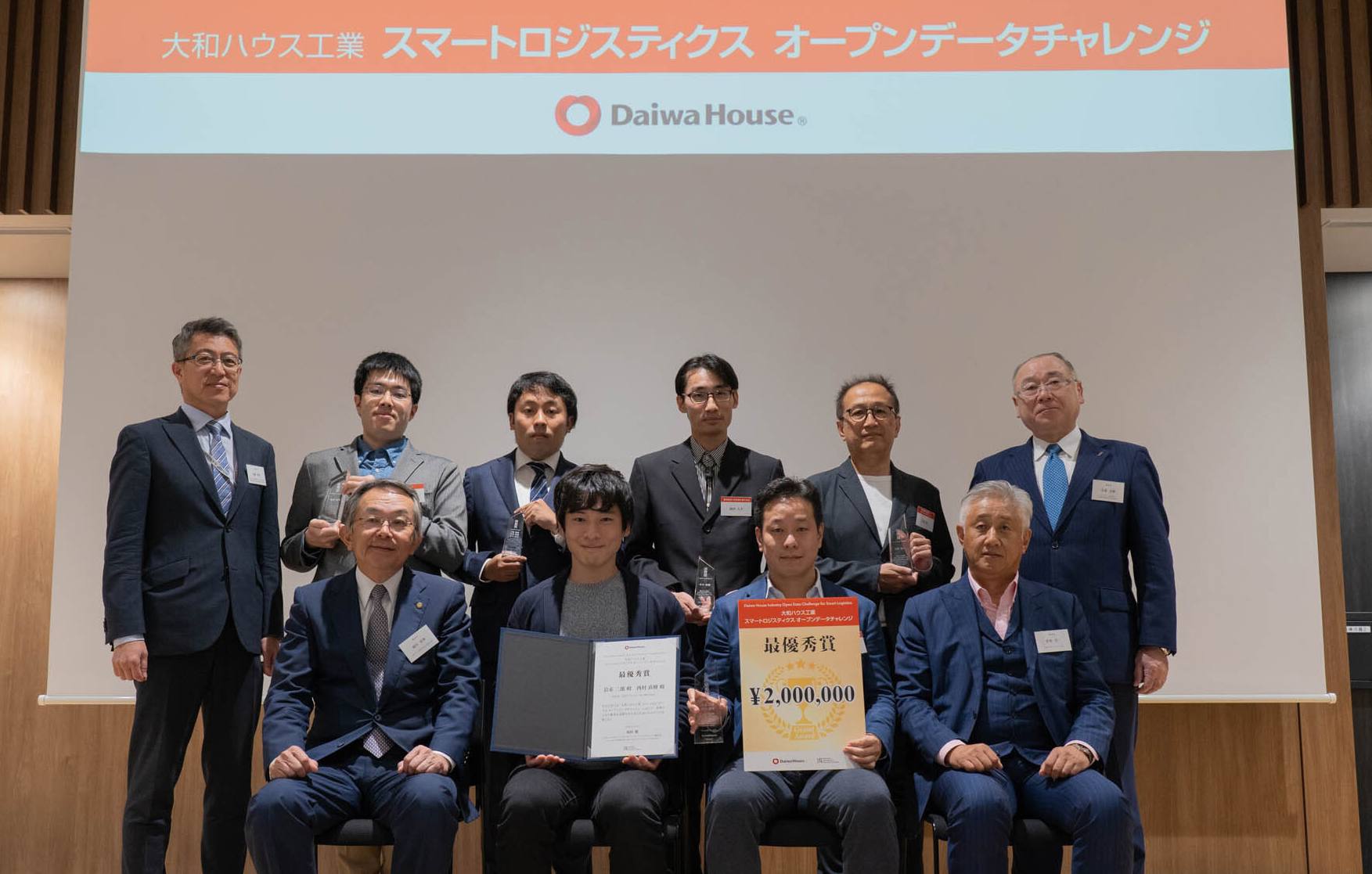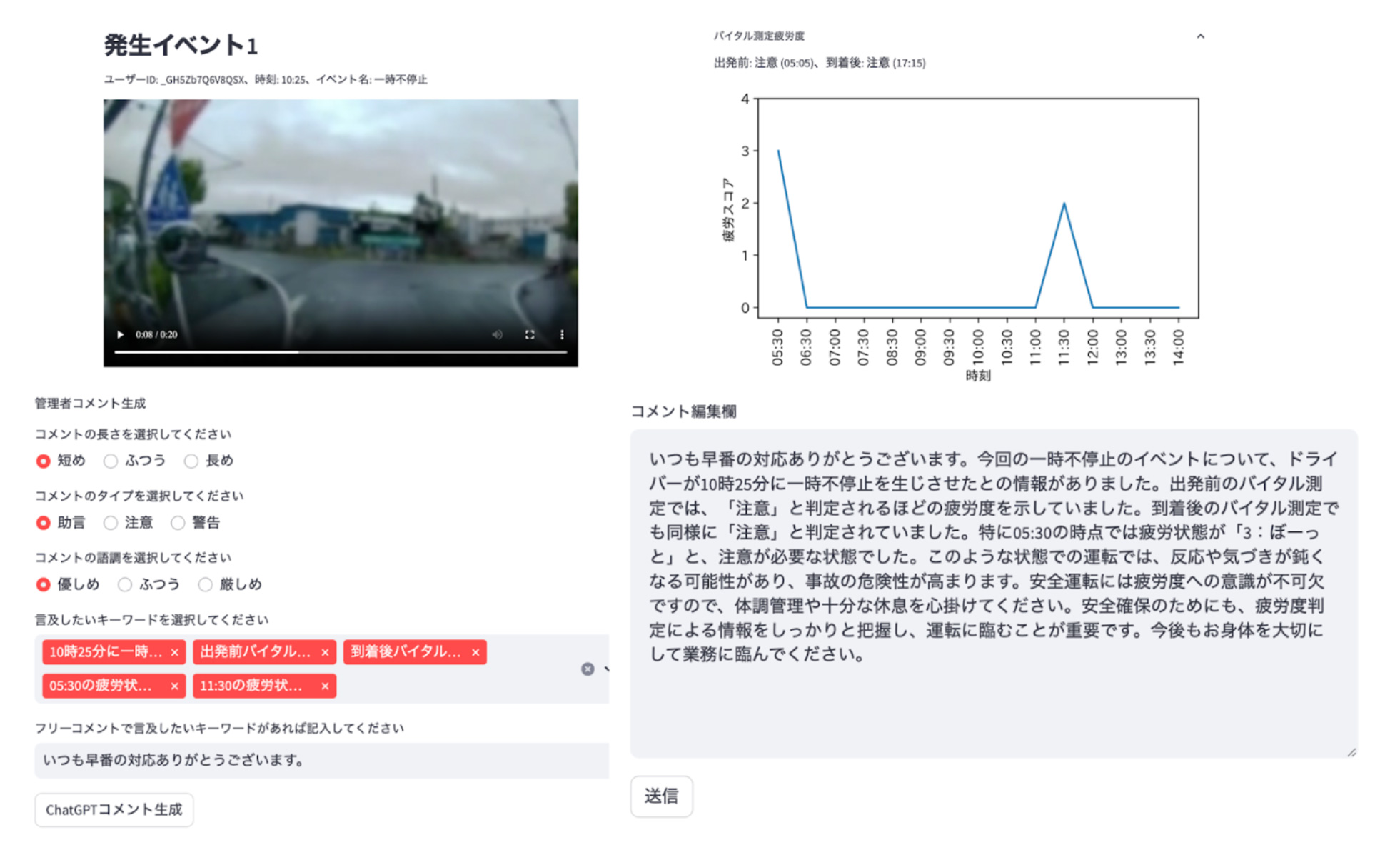


Ken Sakamura (Chief Judge)
Dean of Faculty of Information Networking for Innovation And Design (INIAD), Toyo UniversityIt has been seven years since we held our first Logistics Open Data Contest, and in that time, the circumstances surrounding the logistics industry have changed every day. The logistics industry, which supports the foundation of society, faces a variety of challenges, such as a surge in logistics demand in line with the booming electronic commerce industry in the COVID-19 age and, on the other hand, a shortage of transportation capacity due to the reform of work styles, known as the "2024 problem" in Japan. There is increasing demand for digital transformation (DX) in the logistics industry to solve these issues.
This year's "Daiwa House Industry Open Data Challenge for Smart Logistics" calls for proposals from developers for smart and safe logistics using digital technology, based on actual logistics data obtained from "SSCV-Safety," Logisteed's safety operation management solution. Although the data was relatively unfamiliar to the general public, a wide variety of applications were proposed.
"SSCV Assist for Manager," which won the Grand Prize this time, is based on the concept of using generative AI to provide caring feedback to drivers in an efficient manner. This work roots in the idea of realizing DX in the logistics industry by delegating some of the "care" that traditionally has to rely on human sensibilities to a generative AI. The application of ChatGPT and other generative AI is now being explored around the world, and the presentation of concrete ways to apply the characteristics of this new technology to solving logistics issues was highly praised.
Other First Prizes went to "Hiyari-Hatto Alert," which alerts the user when passing near known places where near-miss incidents happened, "Buji-shirube," which visualizes the locations where near-misses are likely to occur, and "Analysis and Visualization of Fatigue Levels," which presented a report with easy to understand detailed analysis of the data.
For this year's contest, we collaborated with the National Police Agency, which makes available traffic accident statistics as open data, as an open data partner, and as a result, we received many entries that use both data. The essence of the Open Data Challenge is that we can collaborate with various people and create new wisdom by making each other’s data available. I hope that this challenge will help DX in the logistics industry in the future.

Tatsuya Urakawa
Director and Managing Executive Officer, Daiwa House Industry Co., Ltd.Thank you very much for your submissions to the Daiwa House Industry Open Data Challenge for Smart Logistics.
This was the first time in four years that the Smart Logistics Open Data Challenge was held after the COVID-19 age. With the cooperation of Logisteed Corporation in providing data obtained from SSCV-Safety, we solicited entries that utilize truck drivers' vital data, videos and data related to near-miss accidents/incidents, truck location information, etc. We hoped that the entries would help solve issues in the logistics industry as the 2024 problem looms.
After much deliberation, we have decided to give one Grand Prize, three First Prizes, and one Special Award to selected entries among the large number of submitted works. I judged the submissions from three perspectives. The first is its usefulness to drivers and logistics companies (whether it actually can be used), the second is its point of view on solving issues, and the third is the degree to which the data is actually used.
The Grand Prize winner, SSCV Assist for Manager, has an interesting point of view, and the idea of assisting drivers in reviewing their operations, which is influenced heavily by the communication skills of individual operation managers, etc., is a service that has never been offered (or thought of) before, and this will certainly increase convenience in the logistics field.
The First Prize and Special Award winners were chosen from the submitted works that varied in terms of real-time performance that made good use of data and the perfection of the user interface. We hope to see more applications in the future from the perspective of usefulness in solving problems at logistics sites and compelling logistics operators want to use them.
Finally, congratulations to all the winners. And to the many people who participated, thank you for your time and efforts. We hope to receive ideas from many of you again next time, and hope that they will lead to practical applications. We look forward to your continued contributions to the evolution of logistics.
We also look forward to your continued guidance and encouragement to the Daiwa House Group.

Seiki Sato
Senior Managing Executive Officer"SSCV-Safety" is a safety operation management solution that aims to realize a society with zero accidents.
It senses the driver's biometric information and vehicle behavior, analyzes them using AI, and sends real-time warnings to drivers and operation managers to prevent accidents before they occur.
"SSCV-Safety" has already been installed in all vehicles of the Logisteed Group and is widely used by other transportation companies outside the Group. Recently, bus companies and local public bodies are also using it on a trial basis.
The large amount of biometric information and vehicle behavior data obtained from such actual use is extremely valuable. In particular, large-scale data correlating biometric information before, during, and after driving with dangerous behavior of vehicles is said to be unprecedented in the world.
For this reason, we sympathize with the philosophy of this Open Data Challenge and have offered our own data.
We were very impressed with the entries, each of which contained ideas that could contribute to solving social issues.
Among them, the Grand Prize winner, "SSCV Assist for Manager," focused on roll call, a common practice in the transportation industry, and introduced a new technology into it. I think it is a particularly concrete and original work.
The system provides optimal advice based on the driver's biometric data and dangerous behavior of the vehicle to assist the operation manager in talking to the driver during roll call. We believe this will greatly contribute to actual business development.
Through the SSCV and other DX mechanisms, we will contribute to solving social issues the logistics industry faces and developing logistics as social infrastructure.
We hope that the winners of this year's awards will utilize their knowledge and creativity in data analysis to contribute to developing services that enrich people's lives.

Jun'ichi Akiba
Frameworx, Inc.Thank you for the many registrations.
We are grateful to all of you for taking on these difficult challenges.
The judges discussed and selected the Grand Prize winner and First Prize winners. I will not go into the details of the discussions on individual works, but I tell you that we had lively discussions on such topics as "This work could have been done better," and "what we should consider in the context of business usage scenarios.”
I wonder what kind of data comes to mind when you hear the term "logistics data."
Is it inventory data, inbound/outbound data, loading rates, truck location information, sales data, etc.?
In this Open Data Challenge for Smart Logistics, the truck driver vital data and dashboard camera image were made available thanks to the cooperation of Logisteed as well as the truck location information and truck acceleration information.
The truck drivers' vital data included, on top of before and after data, the level of fatigue and alert level analyzed from the vital data measured during driving.
The acquisition of truck drivers' vital data began for the prevention of random accidents caused by lack of attention. Such data has the potential to determine the health status of drivers of other sales vehicles and in general, and "people in general," not just drivers. This challenge is over, but I hope you will continue to consider the beneficial use of such data in the future.
Thank you very much.

Atsushi Kato
Haneda Future Development Co., LtdFirst of all, I am very honored and grateful to have been asked to serve as a judge for this initiative.
This contest reaffirmed that the logistics industry has always been progressive, and that it is proactively introducing and utilizing innovative technology in the business operations.
The attempt to utilize open data, which is expected to be utilized more in the future, is in line with the initiatives for smart city and super city that have been deployed throughout Japan including HANEDA INNOVATION CITY we have developed and operate. I believe this contest has offered very useful case studies for reference to me as a real estate developer.
On the other hand, although I suspect the time constraints of the development period may have been a factor, the superficial performance of some of the individual entries seemed similar to those of the existing systems.
How can the vast amount of data acquired be used to contribute to efficient facility and business operations (energy conservation, labor reduction)? How can we monetize the data collection and analysis in order to continue its implementation? I think these are a common concern for companies and businesses considering data utilization.
The works of all the award winners are excellent, and I believe that they will be further improved and developed for greater efficiency and monetization in the future.
I would like to express my respect for the efforts of all those who participated in this challenge, and I wish for your further development in the future.
"SSCV Assist for Manager" is an automatic feedback generation application that uses ChatGPT API to enhance the feedback function of SSCV-Safety.
Recently, the increase in demand for deliveries has led to drivers working longer hours, and serious accidents caused by overworked drivers have become an issue. Logisteed's SSCV-Safety provides a mechanism to collect and visualize driver operation data, allowing for quick feedback through driver health management and video confirmation of near-miss accident/incident.
However, for managers, producing effective daily feedback is laborious, and psychologically taxing. On the other hand, there is a concern that the mannerism pointed out may lead to a decline in awareness of safe driving for drivers.
In this proposal, in conjunction with the data obtained from SSCV-Safety, the ChatGPT API automatically generates drafts of feedback comments by specifying the length (short, normal, long), type (advice, caution, warning), and tone (gentle, normal, harsh) of the comment. This allows managers to create attentive feedback in a short time, and drivers to maintain a high awareness of traffic safety through feedback in many styles.
This application is an example of AI assisting humans by leveraging ChatGPT's strength in "the ability to generate sentences that take nuance into account." It ensures competitive advantage in business by using SSCV-Safety data.

Logistics is an indispensable infrastructure for all.
Therefore, I created an app that can be used by all road users, believing that helping each other, including those not directly involved in logistics, is one of the factors that make logistics run smoothly.
The function was targeted to support safe driving by making the provided near-miss accident/incident occurrence event data easily understandable and visible to drivers.
The design goals made were as follows.
When analyzing the data, I found that only about 6.6% of the areas had events in common from accident/incident occurrence event data and National Police Agency accident statistics. So, I thought that truck information alone was insufficient for the danger level, and included information from the National Police Agency to indicate the danger level on a five-point scale.
When I used it while driving myself, it seemed to work as expected as it displayed a high level of danger in areas with heavy traffic.
I felt that the actual measurement data provided was a quantification of human experience, so I thought it would be better if the data could be analyzed and be incorporated from multiple angles, e.g.: weather information.

"ぶじしるべ" (Bujishirube) is a web app that helps users efficiently locate areas where safety measures should be taken. Its map displays the user-selected area, which is divided into 240 sections of approximately one kilometer square in each of the north, south, east and west directions. Each section is painted using shades of colors (blue and red) according to the product of the number of near-miss accidents/incidents and the number of vehicles that entered the section during the user-selected period of time.
I focused on the product of the number of near-miss accidents/incidents and the number of vehicles entering the site, rather than the probability of near-miss accidents/incidents relative to the number of vehicles entering the site. By doing this, I made the sections with more near-miss accident/incident occurrence and more vehicles entering the sections stand out on the map than the sections with fewer vehicles entering the sections but extremely high probability of near-miss accidents/incidents. This makes it possible for the users to find the sections where more vehicles would benefit from the new safety measures implemented there.
In addition, the app narrows down the types of near-miss accidents/incidents and vehicle types that users want to analyze and displays them on the map.
For each section on the map, you can check the relationship between the number of near-miss accidents/incidents and the total number of recorded entries for each vehicle type. You can visualize the near-miss accidents/incidents by day, day of the week, and time, and the vehicle entries by day and day of the week using graphs, so you can grasp the characteristics of each section, including the types of vehicles and vehicles that are prone to near-miss accidents/incidents.

The risk of accidents and disasters increases when busy conditions persist in the logistic industry and elsewhere. However, the time that on-site managers and supervisors can devote to the corrective activities is limited. Therefore, I decided to propose a way to identify field operation offices with high workloads in a short period of time. If you can quickly identify the sites that are experiencing high workloads, you can quickly and appropriately deploy resources and adjust workloads, resulting in a more comfortable work environment, which in turn protects the safety and health of your employees.
In my entry, information related to fatigue was aggregated, processed, analyzed, and visualized using TreeMAP and bubble charts. First, TreeMAP can identify seasonal change and trends by business location. In addition, coordinate information is added to each business location and expressed on a bubble chart to enable a more intuitive understanding of the analysis results. As a result, we have been able to identify at a glance the level of fatigue in each season and at each site, and to identify sites that might have a problem.

Quasi-real-time near-misses accident/incident with AI
Proposal and prototyping of a prediction application
This web application provides real-time prediction of near-miss accident/incident risk and supports drivers who use the app.
The overall goal of the app we proposed is to "predict real-time near-miss accident/incident risk during driving using various information such as drivers' vital data measured before and during driving, truck acceleration data, weather, time of day, and National Police Agency's accident data, and notify drivers when the risk level increases." Based on the data accumulated by SSCV in this challenge, we conducted a study and proposed a real-time extension of the "risk assessment of near-miss accident/incident occurrence before driving" by SSCV.
This time, we implemented quasi-real-time prediction using mainly truck drivers' vital data, and made it available as a prototype web app.
We hope this will lead to decrease of near-miss and real accidents/incidents, and other dangerous experiences for drivers.

Secretariat of Daiwa House Industry Open Data Challenge for Smart Logistics
(In YRP Ubiquitous Networking Laboratory)
E-mail: support@daiwa-open-challenge.jp